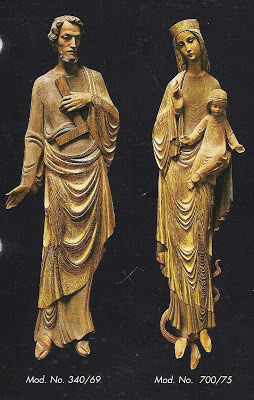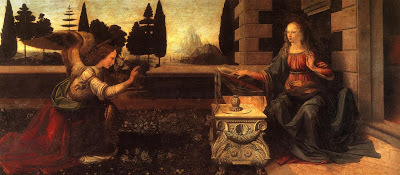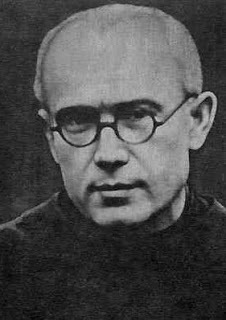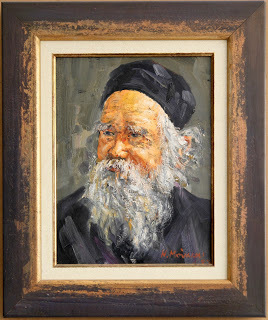Dwight Longenecker's Blog, page 318
December 12, 2011
New OLR Church at NLM

Our new church at Our Lady of the Rosary is featured in an important article at the New Liturgical Movement website. Go here.
Published on December 12, 2011 17:57
The Dignified Beauty of the Romanesque

These images of the Blessed Virgin and St Joseph will be delivered to Our Lady of the Rosary Church tomorrow for installation in the present church and eventually to go into the new church.
Why did I choose these images? First of all, they are modern and original, yet evocative of the Romanesque period--in which our new church will be built. Romanesque is a transitional form of architecture from the early Christian and Byzantine into the early Gothic and high Gothic. As such it holds together two very important periods in the church--the early pre-medieval church and the glorious Gothic of the high middle ages.
In doing so it pulls together two important cultural periods and artistic traditions. The art of the early medieval and Romanesque period still retains the stylized postures and graceful forms of the iconography of the early church, but it is moving towards the more naturalistic or 'realistic' style that would follow in the later middle ages and Renaissance.
Furthermore, the Romanesque style of art and architecture holds together not only the early church and the medieval church, but it is a fascinating bridge between East and West. Springing from Italy and France, it has its roots in the Byzantine of the East in places like Ravenna and Tuscany, but it is also reaching out to the Western tradition, and from there it will develop into the early Gothic.
I have chosen the Romanesque style because it is also works very well for modern Catholic worship. It is suitably austere, and yet expresses the beauty and transcendence of our Catholic worship. Finally, I believe the Romanesque is a suitably 'universal' form of Catholic architecture. It has remained a living tradition within the church for a thousand years, it has travelled well and adapted to different cultural settings and it should therefore offer a strong and vibrant home for Catholics from many different ethnic and cultural traditions. Go here and check the left sidebar for more about these new images.
Published on December 12, 2011 16:05
Catholic Music--Yucch
Jeffrey Tucker comments here on why the music in the majority of Catholic parishes is so execrable.
Published on December 12, 2011 15:41
Angels of Advent
Here is my latest article for National Catholic Register. The four angels of Advent...
Published on December 12, 2011 13:32
The Annunciation the Ark and the Angels

At a pre-Christmas party last evening my favorite Catholic Sunday School teacher was explaining about the significance of the Blessed Virgin Mary in the Old Testament. It all has to do with overshadowing, arks and angel wings.
See, the Ark of the Covenant is that gold covered wooden box which was the throne of God which rested first in the tabernacle and later in Holy of Holies in the temple. Yes, the one that Indiana Jones found buried in Egypt in the movie (only that was pretend). The ark held the tablets of the Ten Commandments, a jar of manna--the Bread from heaven--and Aaron's staff which had budded miraculously. On top of the box was a lid topped with images of two angels with their wings spread out to touch each other in a gesture of overshadowing protection for the covenant box and its contents.
The Ark of the Covenant is, of course, an ancient archetype (no pun intended) for the Blessed Virgin. The Ark contained the tablets of the Word of God. She was the bearer of the Word Incarnate. The Ark contained the manna of the wilderness. She held in her womb the Bread of Life. The Ark held the budding staff of Aaron. Within her was the spring of new life from the stump of Jesse. That she is the Ark of the Covenant is seen in Revelation 11-12 where, in John's vision of heaven, he sees the Ark of the Covenant, and immediately afterwards sees the sign of the woman in heaven clothed with the sun who bears the child who rules with the rod of iron.
So the angels overshadow the Ark of the Covenant. Then there is that interesting story of Ruth in the Old Testament. You may remember that the young widow Ruth was entitled to marry her kinsman Boaz, who would look after her. According to custom she presented herself to him, and as a sign of his acceptance of her he takes her under his cloak. Now, the Hebrew word for a cloak is the same as 'angel wings' and is the same root as the word 'to overshadow'. As a sign of betrothal, Boaz "overshadowed" her with his cloak.
Jump forward to the Annunciation and we see that the angel says "the power of the Most High will overshadow you." This "overshadowing" therefore alludes to the angel wings, and to Boaz' cloak of betrothal and to the wings of the angels that overshadowed the Ark of the Covenant. Thus in one little word the full imagery of the Old Testament prophecies about the Blessed Mother are brought to fulfillment. Also, we see why that curious (and seemingly superfluous) story of Ruth was included in the Old Testament.
So, to those non Catholics who protest that there is not much about Mary in the Bible--she is there woven through the Scriptures through symbol and sign and archetype. Mary the Ark of the Covenant, who bears the Word of God Incarnate, the Bread of Life, is overshadowed by the angels--the powerful messengers of the Lord. Ruth--the type of the virtuous bride--is overshadowed by the cloak of Boaz--bringing forward the nuptial imagery in which the Virgin becomes the Spouse of the Holy Spirit and Mother of the Church--which in turn points forward to the nuptial imagery of the Church as the Bride of Christ.
And all of this captured in the moment when the Angel and the Girl are met. For more learned details on this go to Christian's blog: Smaller Manhattans.
Published on December 12, 2011 12:44
Catholicism and Atheism
I've got this gadget on my home page that generates quotable quotes. You don't know what you're going to get next. Some are funny, some wise, some rude, some silly, some stupid.
My favorite silly one is from Groucho Marx: "Time flies like an arrow. Fruit flies like a banana." Geddit?
Anyway, there's one from George Bernard Shaw today, "There is only one religion, though there are a hundred versions of it." This is typical of Shaw--who regularly debated with Chesterton about most anything and everything. It's typical because an awful lot of what he wrote seems to be witty or wise on first hearing, and on reflection turns out to be silly and stupid. His aphorisms are sort of anti-Chestertonian the way Satan is anti-St Michael.
What on earth does he mean that "there is only one religion, though there are a hundred versions of it?" What he means is that all the religions are valid ways to the same truth. It's not really much more than "Faith is like a mountain and we are all climbing up a different path." This is only a short hop from the subjective quote about "All searching for God in our own way." which is only a short hop from "Let us all find our own Truth" or the classic, "I'm interested in spirituality but not religion."
Shaw is right that there is only one religion, but he is wrong in saying there are a hundred versions of it. If it is a religion at all, then there can only be one version. There may be a hundred perversions of that one version, but there is only one version.
What I mean by saying that "if it is a religion at all, then there can only be one version." Is that a religion must be concrete if it is to be a religion. It must consist of something. Vague 'religious' sentiment doesn't count. Dreamy feelings of 'unity with the cosmos' are unreliable. A moist eye at the sight of a puppy or kitten does not constitute religion. A religion has dogma. It has something you can get your head around and discuss and debate. A religion has a moral philosophy. It has a history. It involves real people. It has a liturgy. It has books and words and rituals and actions, and all these things are either true or false.
Catholicism--therefore is a religion. So it Hindusim and Islam and Judaism and Buddhism and Jehovah's Witness-ism and a whole long list of other religions that have something to them. Why then did I say that there can only be one version of religion? Because if religion, by definition, consists of something. If there is something solid to it, then that something solid must be either right or wrong--true or false. It can't simply be an interesting past time or an amusing hobby for people who like that sort of thing. If it is a religion it claims not only to be interesting or amusing but it claims to be true, so therefore we must examine whether it is true or not.
If Catholicism is true, than the other religions are not other versions of it. They are either pre-versions of it or perversions of it. Religions that are more ancient than Catholicism are pre-versions--in other words, they are pointers in their own way to the fullness of the Catholic faith. Animism and paganism and Hinduism and Buddhism and Shinto-ism and Judaism all--to a greater or lesser extent--point forward to the fullness of the revelation in Jesus Christ.
The other religions that come after Catholicism are perversions of it--Islam and Protestantism and whatever other new fangled New Age religions are out there are all, in some way reactions against the monolithic truth of the Catholic faith.
As such they either lead people to the fullness of the Catholic faith, or they lead people into atheism. Of course this process does not take place for many people. They don't follow the logic. They don't think it through. They don't have "perfectly consistent minds." Nevertheless, it is true, as Bl. John Henry Newman has written, there is "no medium in true philosophy between atheism and Catholicism... a perfectly consistent mind, under those circumstances in which it finds itself here below must embrace either the one or the other."
My favorite silly one is from Groucho Marx: "Time flies like an arrow. Fruit flies like a banana." Geddit?
Anyway, there's one from George Bernard Shaw today, "There is only one religion, though there are a hundred versions of it." This is typical of Shaw--who regularly debated with Chesterton about most anything and everything. It's typical because an awful lot of what he wrote seems to be witty or wise on first hearing, and on reflection turns out to be silly and stupid. His aphorisms are sort of anti-Chestertonian the way Satan is anti-St Michael.
What on earth does he mean that "there is only one religion, though there are a hundred versions of it?" What he means is that all the religions are valid ways to the same truth. It's not really much more than "Faith is like a mountain and we are all climbing up a different path." This is only a short hop from the subjective quote about "All searching for God in our own way." which is only a short hop from "Let us all find our own Truth" or the classic, "I'm interested in spirituality but not religion."
Shaw is right that there is only one religion, but he is wrong in saying there are a hundred versions of it. If it is a religion at all, then there can only be one version. There may be a hundred perversions of that one version, but there is only one version.
What I mean by saying that "if it is a religion at all, then there can only be one version." Is that a religion must be concrete if it is to be a religion. It must consist of something. Vague 'religious' sentiment doesn't count. Dreamy feelings of 'unity with the cosmos' are unreliable. A moist eye at the sight of a puppy or kitten does not constitute religion. A religion has dogma. It has something you can get your head around and discuss and debate. A religion has a moral philosophy. It has a history. It involves real people. It has a liturgy. It has books and words and rituals and actions, and all these things are either true or false.
Catholicism--therefore is a religion. So it Hindusim and Islam and Judaism and Buddhism and Jehovah's Witness-ism and a whole long list of other religions that have something to them. Why then did I say that there can only be one version of religion? Because if religion, by definition, consists of something. If there is something solid to it, then that something solid must be either right or wrong--true or false. It can't simply be an interesting past time or an amusing hobby for people who like that sort of thing. If it is a religion it claims not only to be interesting or amusing but it claims to be true, so therefore we must examine whether it is true or not.
If Catholicism is true, than the other religions are not other versions of it. They are either pre-versions of it or perversions of it. Religions that are more ancient than Catholicism are pre-versions--in other words, they are pointers in their own way to the fullness of the Catholic faith. Animism and paganism and Hinduism and Buddhism and Shinto-ism and Judaism all--to a greater or lesser extent--point forward to the fullness of the revelation in Jesus Christ.
The other religions that come after Catholicism are perversions of it--Islam and Protestantism and whatever other new fangled New Age religions are out there are all, in some way reactions against the monolithic truth of the Catholic faith.
As such they either lead people to the fullness of the Catholic faith, or they lead people into atheism. Of course this process does not take place for many people. They don't follow the logic. They don't think it through. They don't have "perfectly consistent minds." Nevertheless, it is true, as Bl. John Henry Newman has written, there is "no medium in true philosophy between atheism and Catholicism... a perfectly consistent mind, under those circumstances in which it finds itself here below must embrace either the one or the other."
Published on December 12, 2011 08:51
Perfect Love
Published on December 12, 2011 07:09
December 11, 2011
Question Time
See if this gets a discussion going in the combox: Can Satan repent?
Published on December 11, 2011 03:46
December 9, 2011
Clear and Present Danger
Read this article by the Dark Lord Shea-uman about the coming infringement on human rights which would be made possible by a new bill going through Congress.
Published on December 09, 2011 10:42
December 8, 2011
St Maximilian Kolbe

"Be calm, love one another, bearing with one another's defects, so that your interior serenity may draw the souls of the pagans to the Immaculate. In fact, with the help of the Immaculate, not only can we do all things, but we can also endure all things." --- St Maximillian Kolbe
More here.
Published on December 08, 2011 14:28
Dwight Longenecker's Blog
- Dwight Longenecker's profile
- 80 followers
Dwight Longenecker isn't a Goodreads Author
(yet),
but they
do have a blog,
so here are some recent posts imported from
their feed.




